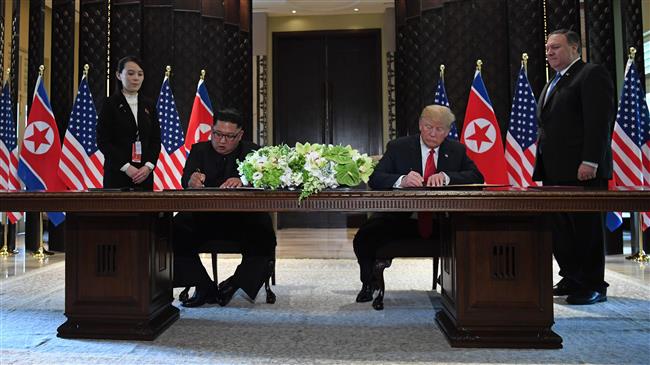
RNA - The two leaders met with plenty of photo ops and little time for talk at Capella Hotel on the resort island of Sentosa.
Kim committed himself only to working "towards" the denuclearization of the Korean Peninsula, a broad church that leaves open the possibility of mutual disarmament talks rather than unilateral scrapping of his nuclear program.
The agreement includes a pledge from Kim to rid the troubled peninsula of nuclear arsenal, but the commitment was vaguely worded.
Missing from the joint statement was the definition promoted up until now by the Trump administration of “complete, verifiable, irreversible dismantlement”.
Asked at a press briefing why those terms were missing, Trump said “There was no time. I am here one day.”
The US president, in response to another question as to how he could ensure Kim’s undertakings would be any more solid, said, “Can you ensure anything? You can’t ensure anything.”
“I just feel very strongly, my instincts, my ability, my talent, that they want to make a deal,” Trump said.
The US president insisted that he believed Kim was determined to disarm, adding that at the end of the summit the North Korean leader offered to destroy an engine testing site that is part of its missile program.
Trump said he accepted that dismantling North Korea’s nuclear weapons would take a long time, but it would be carried out “as fast as it can be done scientifically, ... mechanically”.
Experts say denuclearization is the longstanding policy of the government in Pyongyang, but North Korea interprets this as being a gradual process in which other nuclear powers will also disarm.
North Korea also wants the United States to stop supporting South Korea and Japan through its nuclear umbrella.
Senator Marco Rubio, a member of the US Senate committee on foreign relations, has admitted to concerns about how diplomacy with North Korea will turn out.
According to Nicholas Kristoff, a New York Times columnist, Trump was “hoodwinked” at the summit into suspending military exercises in South Korea and secured very little in return.
Kristoff writes: The most remarkable aspect of the joint statement was what it didn’t contain. There was nothing about North Korea freezing plutonium and uranium programs, nothing about destroying intercontinental ballistic missiles, nothing about allowing inspectors to return to nuclear sites, nothing about North Korea making a full declaration of its nuclear program, nothing about a timetable, nothing about verification, not even any clear pledge to permanently halt testing of nuclear weapons or long-range missiles.
Kim seems to have completely out-negotiated Trump, and it’s scary that Trump doesn’t seem to realize this. For now Trump has much less to show than past negotiators who hammered out deals with North Korea like the 1994 Agreed Framework, which completely froze the country’s plutonium program with a rigorous monitoring system ...
For now at least, Trump seems to have been snookered into the same kind of deeply frustrating diplomatic process with North Korea that he has complained about, but that is far better than war.
Even so, it’s still bewildering how much Trump gave and how little he got. The cancellation of military exercises will raise questions among our allies, such as Japan, about America’s commitment to those allies.
Kim also undertook to cooperate with the United States in the recovery of the remains of US soldiers killed in the Korean war, Washington's longstanding request.
Trump-Kim summit more like 'a big welcome party'
Reacting to the outcome of the summit, Beatrice Fihn, the head of the International Campaign to Abolish Nuclear Weapons (Ican), said in a posting on Twitter, “We support diplomacy and peaceful solutions. But there is no agreement on nuclear disarmament and this all looked more like a big welcome party to the nuclear-armed club.”
Before Trump’s press conference, reporters were shown a video where the US president said he had played to Kim and his aides toward the end of their talks. The video was produced by Destiny Productions and was presented in Korean and English in the style of an action movie trailer.
During their public exchanges, just a few months after the pair had exchanged insults and threatened imminent war, they went out of their way to be gracious. Trump even declared it an “honour” to be sitting next to Kim.
Even before they had left their separate hotels and driven to the summit venue, Trump used Twitter to claim victory and hit back at his critics.
“The fact that I am having a meeting is a major loss for the US, say the haters & losers,” Trump wrote. “We have our hostages, testing, research and all missle [sic] launches have stoped [sic], and these pundits, who have called me wrong from the beginning, have nothing else they can say! We will be fine!”
Crowds of people on the streets of Singapore cheered Kim like a visiting celebrity, and images of his meeting with Trump were broadcast around the world.
For both men, the high-stake encounter was the most consequential meeting of their lives, addressing the future of North Korea’s nuclear arsenal and a peace agreement to end the precarious and tense 65-year limbo that has endured since the Korean war.
According to Press TV, the meeting was the first time a sitting US president met North Korea's leader, and caps a remarkable turnaround for the two. Last year saw the pair sling insults at each other, while North Korea conducted several ballistic missile tests in defiance of the US and its allies.
Pyongyang is believed to have at least two dozen warheads, including a thermonuclear bomb, and is close to building an intercontinental ballistic missile capable of delivering a warhead to the US mainland.
Kim declared in the new year that his administration had completed its mission to build a nuclear deterrent, and since then has suspended nuclear and missile tests. Negotiations to hold the summit began in March, brokered by the South Korean government.
847/940